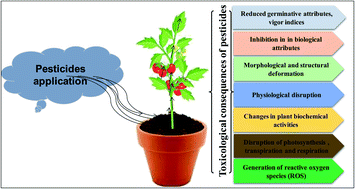Physiological and oxidative stress responses of Solanum lycopersicum (L.) (tomato) when exposed to different chemical pesticides†
Abstract
Pesticide overuse can have negative effects on developmental processes of non-target host plants. By increasing reactive oxygen species (ROS) levels, pesticides negatively affect cellular metabolism, biochemistry and physiological machinery of plants. Considering these problems, the current study was planned to assess the effect of three different groups of pesticides, namely diazinon (DIZN), imidacloprid (IMID) and mancozeb (MNZB) on Solanum lycopersicum L. (tomato). In general, pesticides resulted in a progressive decrease in physiological and biometric parameters of S. lycopersicum (L.), which varies significantly among concentrations and species of pesticides. Among them, 200 μgMNZB mL−1 had the most severe negative impact and reduced germination rate, root biomass, chl a, chl b, total chlorophyll and carotenoids by 62, 87, 90, 88, 92 and 90%, respectively. In addition, higher doses of pesticides greatly reduced the flowering, fruit attributes and lycopene content. Furthermore, plants exposed to 200 μgDIZN mL−1 showed a progressive drop in root cell viability (54% decrease), total soluble sugar (TSS) (64% decrease) and total soluble protein (TSP) (67% decrease) content. Data analysis indicated that greater doses of pesticides dramatically raised ROS levels and induced membrane damage through production of thiobarbituric acid reactive substances (TBARS), as well as increased cell injury. To deal with pesticide-induced oxidative stress, plants subjected to greater pesticide dosages, showed a substantial increase in antioxidant levels. For instance, ascorbate peroxidase (APX), catalase (CAT), superoxide dismutase (SOD), peroxidase (POD) and guaiacol peroxidase (GPX) were maximally increased by 48, 93, 71, 52 and 94%, respectively following 200 μgMNZB mL−1 soil exposures. Additionally, under a confocal laser scanning microscope (CLSM), pesticide exposed S. lycopersicum (L.) roots stained with 2′,7′-dichlorodihydrofluorescein diacetate (2′7′-DCF) and 3,3′-diaminobenzidine, exhibited an increased ROS production in a concentration-dependent manner. Further, elevated pesticide concentrations resulted in alterations in mitochondrial membrane potential (ΔΨm) and cellular death in roots, as evidenced by increased Rhodamine 123 (Rhd 123) and Evan's blue fluorescence, respectively. These findings clearly showed that applying pesticides in excess of permissible amounts might induce oxidative stress and cause oxidative damage in non-target host plants. Overall, the current study indicates that a thorough and secure method be used before selecting pesticides for increasing production of agronomically important vegetable crops in various agro-climatic zones.



 Please wait while we load your content...
Please wait while we load your content...